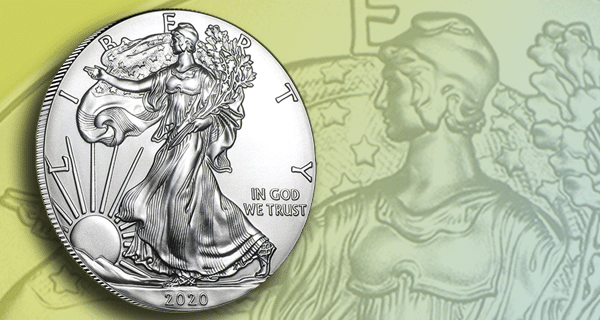It's Almost Time for Silver Eagles!
Nov 20th 2019

We are approaching that time of year again... the time when all the silver bugs eagerly await the release of the newest Silver Eagle. The American Silver Eagle dollar is one of the most popular bullion coins among collectors. This big, bold and bodacious one ounce silver coin generates a lot of numismatic interest and questions from collectors that are new to the hobby. We've rounded up a few of the usual inquiries:
What's the story behind the American Silver Eagle?
The first Silver Eagle was minted 33 years ago on October 29th, 1986 at the San Francisco Mint. Presiding over the striking ceremony, then Secretary of Treasury James A. Baker III said as he reached for the button on the coin press in front of him, "I don't need a pick and shovel to start the San Francisco Silver Rush of 1986." Although mass production of the coin began in October, the coin wasn't released until late November of that year. The initial inventories of the 1986 Silver Eagles quickly sold out, foreshadowing the popularity of a decades-long series and proving that a pick and shovel were indeed unnecessary to facilitate a modern silver rush.
The Silver Eagle shares its obverse design with sculptor Adolph A. Weinman's 1916-1947 Walking Liberty half dollar; which is perhaps one of the most beloved numismatic images of all time. On its reverse, a heraldic eagle and shield emulates the Great Seal of the United States designed by John Mercanti, the twelfth Chief Engraver for the Mint.
Why are these coins not available until mid-January?
Many countries release their collectible and uncirculated coins for the new year by the beginning of January and sometimes as early as November or December. Silver Eagles are struck late in the previous year, but are not released by the Mint until the beginning of January.
Here's where the process gets complicated. The Mint does not sell Silver Eagles directly to collectors, instead it only releases them to authorized dealers. These primary dealers have specific regulations to meet, one of which is the ability to purchase 25,000 coins in a single order.
Consider a Silver Eagle's journey — the packing and distribution from the U.S. Mint, and then sorting, packing and distribution to primary dealers to be dispersed to secondary agencies. The secondary dealers then sort, package and distribute to individual buyers — it becomes apparent why these well-traveled coins take so long to land in the hands of collectors.
Why does a Silver Eagle cost more than the price of an ounce of silver?
It would make sense that these one ounce coins should cost about the going rate for silver, but many factors other than the market price of the precious metal effect the pricing of these issues.
The United States Mint has many production costs to cover in the minting of these coins, which raises the price right out of the gate well beyond the cost of the initial silver purchase. Also, the U.S. Mint is a for-profit operation and they distribute these issues to make money.
When the Mint releases their coins, they charge a premium to the primary distributors to cover distribution costs. In a trickle-down effect, the primary distributors charge their own premium for their costs and then secondary distributors add their premium in turn.
Despite the cost and issuance delay, the Silver Eagle will remain a favorite among collectors and investors. According to the U.S. Mint, more than 130 million Silver Eagles have been sold since 1986 — a testament to the popularity of this coin.

